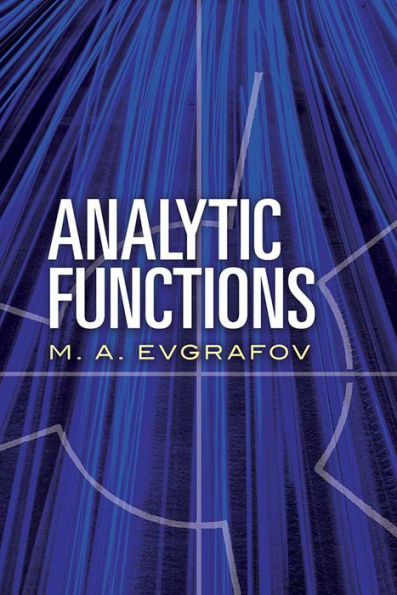

Paperback(Translatio)
-
PICK UP IN STORECheck Availability at Nearby Stores
Available within 2 business hours
Related collections and offers
Overview
Starting with an introductory chapter containing the fundamental results concerning limits, continuity, and integrals, the book addresses analytic functions and their properties, multiple-valued analytic functions, singular points and expansion in series, the Laplace transform, harmonic and subharmonic functions, extremal problems and distribution of values, and other subjects. Chapters are largely self-contained, making this volume equally suitable for the classroom or independent study.

Product Details
| ISBN-13: | 9780486837604 |
|---|---|
| Publisher: | Dover Publications |
| Publication date: | 09/18/2019 |
| Series: | Dover Books on Mathematics |
| Edition description: | Translatio |
| Pages: | 352 |
| Sales rank: | 1,113,681 |
| Product dimensions: | 6.00(w) x 8.90(h) x 0.80(d) |
About the Author
Read an Excerpt
PREFACE
The present text is designed for students and other readers acquainted with the fundamentals of mathematical analysis as presented in a year of advanced calculus.
The order of presentation of material in this textbook is significantly different from that of other texts in analytical function theory. We shall give a rigorous discussion of the theory of multiple-valued analytic functions presented on the basis of analytic continuation. This theory is presented toward the very end in many textbooks in use today, but it enters in the present book much nearer the beginning (Chap. III). A strong argument can be made for such arrangement of the material. First of all, from the point of view of logic, analytic continuation plays no less a role in the theory of complex variables than that of the theory of limits in analysis. Second, it is appropriate from the purely practical point of view, since the earlier utilization of analytic continuation allows great economy in space and time in the presentation to follow. The usual objection made against this arrangement is based on the opinion that analytic continuation is difficult to understand. However, the difficulty is greatly exaggerated. Moreover, whatever the difficulties, they must be overcome in any event upon the introduction of the elementary multiple-valued functions, and by more artificial (and therefore less intelligible) means.
In any case, my lecturing experience in the theory of analytic functions at the Moscow Physical-Technical Institute has convinced me that two or three difficult (but completely accessible) lectures were fully justified by the better understanding of the material that followed. The exercises could be gone over much more easily , since the problem of isolating analytic branches is laborious and difficult to understand.
It was also valuable in that the student developed from the beginning a correct and accurate point of view of the subject studied.
In the writing of the book I tried to make the separate chapters as independent as possible of one another. The object of this was to make the book available for a variety of courses with consider able variation in content. The volume of material presented in the text considerably exceeds the content of the courses usually given at the Institute. It is worthwhile to stress that all the chapters are written on a level completely accessible to third year students.
I will now point out the relations among the chapters.
Chapter I need only be employed for purposes of reference. Chapters II-IV are essential for all that follows. Chapters VI and VII have no connection with V and VIII-X. Chapter VIII relies to a considerable extent on Chapter V, and itself serves as the base for the two that follow. Chapters IX and X have only slight connections with one another.
A subject and name index is included at the end of the book.
In conclusion I should like to thank all those who contributed to my work on this book. First of all, I thank my teachers: Corresponding Member of the Academy of Sciences of the U. S.S.R. A. O. Gel'fond and Academician M. V. Keldysh. My views took shape under the influence of my discussions with them, and this influence is more noticeable in this book than in other of my works. My students helped me very much: Candidates in the Physical-Mathematical Sciences I. S. Arshon and G. M. Mordasova, who carefully read all the variants of the manuscript as they made their appearance. V. V. Zarutskaya, the editor of this book, helped me very much in finishing the final version of the manuscript. I am very thankful to professors V. B. Lidskiy and B. V. Shabat, and to docents O. V. Lokutsievskiy and M. B. Fedoryuk for their helpful observations.
M. A. Evgrafov
(Continues…)
Excerpted from "Analytic Functions"
by .
Copyright © 1996 Scripta Technica, Inc..
Excerpted by permission of Dover Publications, Inc..
All rights reserved. No part of this excerpt may be reproduced or reprinted without permission in writing from the publisher.
Excerpts are provided by Dial-A-Book Inc. solely for the personal use of visitors to this web site.
